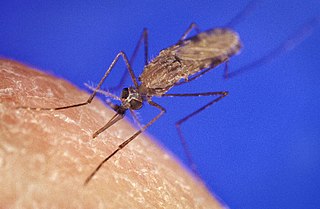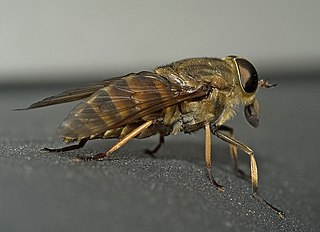
The Bombyliidae are a family of flies, commonly known as bee flies. Adults generally feed on nectar and pollen, some being important pollinators. Larvae are mostly parasitoids of other insects.

The Culicomorpha are an infraorder of Nematocera, including mosquitoes, black flies, and several extant and extinct families of insects. They originated 176 million years ago, in the Triassic period. There are phylogenetic patterns that are used to interpret bionomic features such as differences in the nature of blood-feeding by adult females, daytime or nighttime feeding by adult females, and occurrence of immature stages in aquatic habitats.

Oestroidea is a superfamily of Calyptratae including the blow flies, bot flies, flesh flies, and their relatives. It occurs worldwide and has about 15,000 described species.

The Asiloidea comprise a very large superfamily insects in the order Diptera, the true flies. It has a cosmopolitan distribution, occurring worldwide. It includes the family Bombyliidae, the bee flies, which are parasitoids, and the Asilidae, the robber flies, which are predators of other insects.

The Lauxanioidea are a superfamily of flies that includes the two large families, the Lauxaniidae and Chamaemyiidae, and the small family Celyphidae. Generally, they are small to medium, densely populated, coloured flies. The Chamaemyiidae live as parasites on insects. The family Celyphidae look like beetles.

Nannochoristidae is a family of scorpionflies with many unusual traits. It is a tiny, relict family with a single extant genus, Nannochorista, with eight species occurring in New Zealand, southeastern Australia, Tasmania, Argentina and Chile. Due to the group's distinctiveness from other scorpionflies, it is sometimes placed in its own order, the Nannomecoptera. Some studies have placed them as the closest living relatives of fleas. Most mecopteran larvae are eruciform, or shaped like caterpillars. Nannochoristid larvae, however, are elateriform, and have elongated and slender bodies. The larvae are aquatic, which is unique among mecopterans. The larvae are predatory, hunting on the beds of shallow streams, primarily on the larvae of aquatic Diptera like chironomids.

The Brachyceran infraorder Tabanomorpha is a small group that consists primarily of two large families, the Tabanidae and Rhagionidae, and an assortment of very small affiliated families, most of which have been included within the Rhagionidae.

The Empidoidea are a large monophyletic superfamily of true flies, the sister taxon to the Muscomorpha (Cyclorrhapha). These two groups are sometimes united in the unranked taxon Eremoneura. There are some 10,000 known species within Empidoidea, which are represented on all continents except Antarctica. They are known to have existed since the Jurassic period.

Apsilocephalidae is a family of flies in the superfamily Asiloidea. It was historically treated as a subfamily within Therevidae, but placed in a separate family in 1991, and subsequently recognized as more distantly related. The family contains three extant genera and at least five extinct genera described from the fossil record.

Atelestidae is a family of flies in the superfamily Empidoidea. The four genera were placed in a separate family in 1983; they were formerly either in Platypezidae or considered incertae sedis. While they are doubtless the most basal of the living Empidoidea, the monophyly of the family is not fully proven. The genus Nemedina seems to represent a most ancient lineage among the entire superfamily, while Meghyperus is probably not monophyletic in its present delimitation, and it is liable to be split up eventually, with some species being placed elsewhere. In 2010, the genus Alavesia, previously only known from Cretaceous fossils, was found alive in Namibia, subsequent species were also described from Brazil.

Acrocerinae is a subfamily of small-headed flies in the family Acroceridae. Their larvae are endoparasites of araneomorph spiders, with the exception of Carvalhoa appendiculata which can develop as ectoparasitoids on their host spiders. Traditionally, the subfamily included the genera now placed in Cyrtinae and Ogcodinae, but the subfamily in this sense was found to be polyphyletic and was split up in 2019.

Panorpida or Mecopterida is a proposed superorder of Endopterygota. The conjectured monophyly of the Panorpida is historically based on morphological evidence, namely the reduction or loss of the ovipositor and several internal characteristics, including a muscle connecting a pleuron and the first axillary sclerite at the base of the wing, various features of the larval maxilla and labium, and basal fusion of CuP and A1 veins in the hind wings. The monophyly of the Panorpida is supported by recent molecular data.

Apystomyiidae is a small family of flies containing the living genus Apystomyia and the extinct genera Apystomimus and Hilarimorphites. The single living Apystomyiidae species, Apystomyia elinguis, is native to California. Species of Hilarimorphites have been described from Mid to late Cretaceous Burmese and New Jersey ambers, while the single Apystomimus species is from the Late Jurassic of Kazakhstan.

Schlingeromyia is an extinct genus of small-headed flies in the family Acroceridae. The genus is known from Upper Cretaceous fossils in Burmese amber from Myanmar. It contains only one species, Schlingeromyia minuta.

Burmacyrtus is an extinct genus of small-headed flies of uncertain placement. The genus is known from Upper Cretaceous fossils in amber from Myanmar. It contains only one species, Burmacyrtus rusmithi.

Fergusonina, the sole genus in the family of Fergusoninidae, are gall-forming flies. There are about 40 species in the genus, all of them producing galls on Eucalyptus, Melaleuca, Corymbia, and Metrosideros species in Australia and New Zealand.
Eremoneura is a clade of flies within the Brachycera that includes the Empidoidea and the Cyclorrhapha and is a sister of the Asilomorpha. They are thought to have evolved around the Mesozoic. The group includes fossils described in the genus Chimeromyia from 125 million year old amber which show both empidoid and cyclorrhaphan characters. The monotypic family Apystomyiidae has also been placed within the Eremoneura as a sister of the Cyclorrhapha.

Zhangsolvidae is an extinct family of brachyceran flies known from the Cretaceous period. Members of the family possess a long proboscis, varying in length between 1.3 and 7 mm depending on the species, and were probably nectarivores. A specimen has been found with preserved Bennettitales pollen, suggesting that they acted as pollinators for extinct gymnosperms. They are considered to be members of the Stratiomyomorpha.

Hymenopterida is a superorder of insects, comprising Hymenoptera and the orders of Panorpida. The superorder is a member of Endopterygota and most closely related to the orders of Neuropterida and Coleopterida.

Tethepomyiidae is an extinct family of small brachyceran flies known from the Cretaceous period of Laurasia. It is part of the extinct superfamily Archisargoidea. The family is characterised by "very large eyes, reduced mouthparts, a highly reduced antennal flagellum, and greatly reduced venation." The ovipositor of Tethepomyia zigrasi has a hypodermic morphology likely used for injecting eggs into hosts.


















